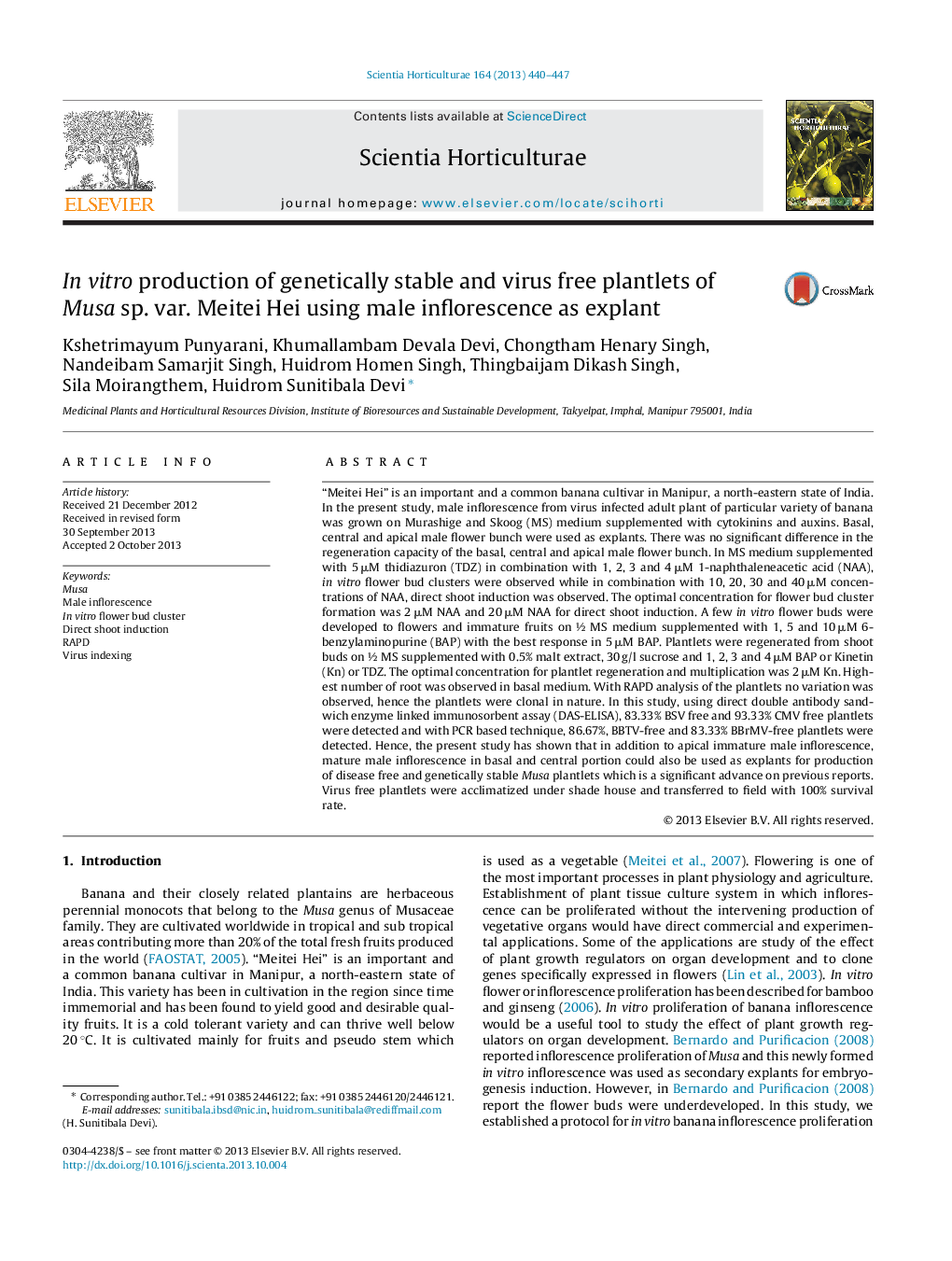| کد مقاله | کد نشریه | سال انتشار | مقاله انگلیسی | نسخه تمام متن |
|---|---|---|---|---|
| 4567091 | 1628834 | 2013 | 8 صفحه PDF | دانلود رایگان |

• Basal, central and apical male flower bunch of ‘Meitei Hei’, an important banana variety of Manipur, grown in Murashige and Skoog (MS) medium supplemented with cytokinins and auxins.
• In vitro flower bud clusters and direct shoot induction were observed.
• RAPD was carried out to determine the genetic stability of regenerated and micropropagated plantlets.
• Regenerated and micropropagated banana plantlets were also tested for the presence of BBTV, BBrMV, BSV and CMV.
• Mature male inflorescence in basal and central portion could also be used as explants for production of disease free and genetically stable Musa plantlets.
“Meitei Hei” is an important and a common banana cultivar in Manipur, a north-eastern state of India. In the present study, male inflorescence from virus infected adult plant of particular variety of banana was grown on Murashige and Skoog (MS) medium supplemented with cytokinins and auxins. Basal, central and apical male flower bunch were used as explants. There was no significant difference in the regeneration capacity of the basal, central and apical male flower bunch. In MS medium supplemented with 5 μM thidiazuron (TDZ) in combination with 1, 2, 3 and 4 μM 1-naphthaleneacetic acid (NAA), in vitro flower bud clusters were observed while in combination with 10, 20, 30 and 40 μM concentrations of NAA, direct shoot induction was observed. The optimal concentration for flower bud cluster formation was 2 μM NAA and 20 μM NAA for direct shoot induction. A few in vitro flower buds were developed to flowers and immature fruits on ½ MS medium supplemented with 1, 5 and 10 μM 6-benzylaminopurine (BAP) with the best response in 5 μM BAP. Plantlets were regenerated from shoot buds on ½ MS supplemented with 0.5% malt extract, 30 g/l sucrose and 1, 2, 3 and 4 μM BAP or Kinetin (Kn) or TDZ. The optimal concentration for plantlet regeneration and multiplication was 2 μM Kn. Highest number of root was observed in basal medium. With RAPD analysis of the plantlets no variation was observed, hence the plantlets were clonal in nature. In this study, using direct double antibody sandwich enzyme linked immunosorbent assay (DAS-ELISA), 83.33% BSV free and 93.33% CMV free plantlets were detected and with PCR based technique, 86.67%, BBTV-free and 83.33% BBrMV-free plantlets were detected. Hence, the present study has shown that in addition to apical immature male inflorescence, mature male inflorescence in basal and central portion could also be used as explants for production of disease free and genetically stable Musa plantlets which is a significant advance on previous reports. Virus free plantlets were acclimatized under shade house and transferred to field with 100% survival rate.
Journal: Scientia Horticulturae - Volume 164, 17 December 2013, Pages 440–447